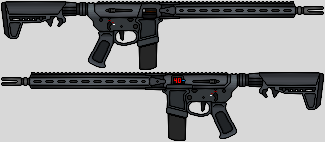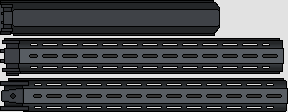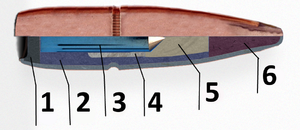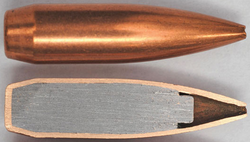mNo edit summary |
No edit summary |
||
| (9 intermediate revisions by one other user not shown) | |||
| Line 1: | Line 1: | ||
[[File: | {{DEFAULTSORT:Adaptive Rifle System, Mark 15}}[[File:MARK15COLLAGE.png|325px|thumb|right|A Mark 15 Mod. 2 rifle with third-generation free-floating handguard, ambidextrous lower receiver assembly, short charging handle, and alternate buttstock assembly.]] | ||
The '''Mark 15 Adaptive Rifle System''' is a compact, magazine-fed, closed-bolt, electronic impulse, | The Ageira Technologies Armament Subsystems XV-15, known in Solas Tempus service as the '''Mark 15 Adaptive Rifle System''', is a compact, magazine-fed, closed-bolt, electronic impulse, radial-delayed blowback-operated automatic rifle employing a high-velocity 6mm caseless round. Designed as a lightweight weapon geared towards offensive operations, the Mark 15 is highly modular and can be easily reconfigured depending on mission needs. | ||
==History== | ==History== | ||
The Mark 15 | The Mark 15 was adopted to replace the aging PDW-30, and is chambered a 6x28mm high-velocity caseless round designed to penetrate modern body armor types. Featuring better penetration and similar range at a smaller size and weight when compared to the 7.62x33mm cased-telescoped round, the round was quickly adopted as a replacement in [[Solas Tempus]] service and serves as a ballistic fallback option for new arrivals, special operations personnel, or for targets requiring alternate methods of disposal. Unlike the PDW however, the Mark 15 was designed from the ground up to be an offensive weapon. | ||
A series of officially-sanctioned attachments, dubbed the Special-Purpose Enhanced Combatant Modification package (SPECMOD), was devised for the Mark 24 SABER system and is fully compatible with Mark 15 series of rifles. | A series of officially-sanctioned attachments, dubbed the Special-Purpose Enhanced Combatant Modification package (SPECMOD), was devised for the Mark 24 SABER system and is fully compatible with Mark 15 series of rifles. | ||
| Line 10: | Line 10: | ||
==Design== | ==Design== | ||
Like the Mark 30 PDW, the Mark 15 operates on an electronic impulse, delayed-blowback | Like the Mark 30 PDW, the Mark 15 operates on an electronic impulse, delayed-blowback action, although the radial-delayed blowback system rotates the bolt as it accelerates the bolt carrier, thus increasing effective bolt carrier mass and reducing felt recoil, as well as improving overall reliability. However, unlike the Mark 30, the Mark 15 feeds from conventional 50-round quadstacked U-bend conveyor "casket" box magazines. The weapon has three firing modes: safe, semi, and auto. | ||
[[File:Rails.png|thumb|right|Mark 15 handguards, from top to bottom: Original production, first-generation "heatshield" handguard with electromagnetic mounting panels, second-generation lightweight mechanically-modular handguard, third-generation lightweight mechanically-modular handguard.]] | |||
For amenities, the Mark 15 features an ambidextrous fire selector, magazine release, and bolt catch, ammunition counter, 6-position adjustable buttstock, and a fully-customizable handguard with 4 modular rail units. The design is fully modular, and can accept a variety of sights, stocks, grips, and other accessories, as well as longer or shorter barrels. | For amenities, the Mark 15 features an ambidextrous fire selector, magazine release, and bolt catch, ammunition counter, 6-position adjustable buttstock, and a fully-customizable handguard with 4 modular rail units. The design is fully modular, and can accept a variety of sights, stocks, grips, and other accessories, as well as longer or shorter barrels. The original handguard was an elongated reproduction of the shortened Ageira heatshield for extremely-short-barreled rifles with added electromagnetic mounting surfaces at the 3, 6, 9, and 12 o'clock positions. This proved to be fairly heavy and unwieldy when employed in rifle-length configurations, and so Solas Tempus R&D pursued the Ageira lightweight rail design, adopting their own mounting solution to the receiver without a physical example. The second-generation handguard served well in it's intended purpose, though the in-house developed mounting solution was eventually deemed not strong enough for duty use, causing severe loss of zero after prolonged use in rougher field conditions. To remedy this, a heavier, stronger 4-bolt iridium-reinforced mounting system was developed, fitted with an integrated slot for quick-detach sling mounts. Rumors of a fourth-generation one-piece upper receiver are currently floating around the [[TACCOM]] and SPECCOM communities. | ||
The Mark 15 is entirely made from special stamped temperature-resistant alloys, with most parts made from high-grade polymers and alloys for durability and longevity. The result of this is a rather lightweight platform, at roughly 3 kilograms fully loaded with a 50-round magazine, but also one that is intensely durable and can withstand all types of environments and pressures. | The Mark 15 is entirely made from special stamped temperature-resistant alloys, with most parts made from high-grade polymers and alloys for durability and longevity. The result of this is a rather lightweight platform, at roughly 3 kilograms fully loaded with a 50-round magazine, but also one that is intensely durable and can withstand all types of environments and pressures. | ||
==Ammunition== | ==Ammunition== | ||
[[File:Mk30.png|300px|thumb|right|A cross-section diagram of a '''Mk 30 bullet'''. '''1.''' Tritanium Alloy, '''2.''' Steel Cup, '''3.''' DU Penetrator, '''4.''' Zirconium Powder, '''5.''' HE Mix, '''6.''' Incendiary Mix.]] | [[File:Mk30.png|300px|thumb|right|A cross-section diagram of a '''Mk 30 bullet'''. '''1.''' Tritanium Alloy, '''2.''' Steel Cup, '''3.''' DU Penetrator, '''4.''' Zirconium Powder, '''5.''' HE Mix, '''6.''' Incendiary Mix.]] | ||
There are several main types of ammunition designed specifically for the Mark 15, | There are several main types of ammunition designed specifically for the Mark 15, most of which are downscaled variations of [[PDW-30/C]] ammunition. | ||
===Mark 35 Mod. 0 HE-I/AP=== | ===Mark 35 Mod. 0 HE-I/AP=== | ||
The standard 137-grain boattail 6mm Mark 35 Mod. 0 High-Explosive, Incendiary, Armor-Piercing round is composed of incendiary mix, zirconium powder, HE mix, and a depleted uranium penetrator inside a steel cup, all encased in a copper jacket. It is designed to defeat most common forms of body armor and explode inside the target, with a pyrotechnical detonation train instead of a manual fuse that sets off the HE filler and incendiary mix, to ensure maximum effect and terminal ballistic consistency. Fired from a 10.3-inch unsuppressed barrel, the Mk 35 round generates muzzle velocities of over 800 m/s, with an effective range of 900 meters. AP-I/HE rounds are marked with green tips. | The standard 137-grain boattail 6mm Mark 35 Mod. 0 High-Explosive, Incendiary, Armor-Piercing round is composed of incendiary mix, zirconium powder, HE mix, and a depleted uranium penetrator inside a steel cup, all encased in a copper jacket. It is designed to defeat most common forms of body armor and explode inside the target, with a pyrotechnical detonation train instead of a manual fuse that sets off the HE filler and incendiary mix, to ensure maximum effect and terminal ballistic consistency. Fired from a 10.3-inch unsuppressed barrel, the Mk 35 round generates muzzle velocities of over 800 m/s, with an effective range of 900 meters. AP-I/HE rounds are marked with green tips. | ||
| Line 43: | Line 41: | ||
[[File:XV15PhaserUpper.png|505px|thumb|right|A Type 15 full upper receiver assembly.]] | [[File:XV15PhaserUpper.png|505px|thumb|right|A Type 15 full upper receiver assembly.]] | ||
===Type 15 Phaser Full Upper Receiver=== | ===Type 15 Phaser Full Upper Receiver=== | ||
The Mark 15 is shipped with a specialized complete upper receiver assembly which mimics the construction, operation, and effectiveness of the Type 3 phaser rifle. It is a drop-in kit, which utilizes the two-pin upper/lower receiver layout of the Mark 15 platform, although the weapon is wholly contained with the upper receiver and does not require input from the lower aside from the trigger. It utilizes the same miniaturized power cell as a late-2300s Type 3 phaser rifle, and has a standard barrel length of 14.5 inches. The barrel itself has been thinned to fit within a standard carbine-length free-floating Mark 15 handguard with Grade 8 tritanium alloy bolts, but the smaller nature and proximity to a thinner modular handguard results in increased heat transfer and faster heating up of the barrel. Despite the drawbacks, the ease of logistics and comparable power and flexibility to the Type 3 rifle when embedded with standard security forces has made the Type 15 PFU popular with SPECCOM forces. | The Mark 15 is shipped with a specialized complete upper receiver assembly which mimics the construction, operation, and effectiveness of the Type 3 [[phaser]] rifle. It is a drop-in kit, which utilizes the two-pin upper/lower receiver layout of the Mark 15 platform, although the weapon is wholly contained with the upper receiver and does not require input from the lower aside from the trigger. It utilizes the same miniaturized power cell as a late-2300s Type 3 phaser rifle, and has a standard barrel length of 14.5 inches. The barrel itself has been thinned to fit within a standard carbine-length free-floating Mark 15 handguard with Grade 8 tritanium alloy bolts, but the smaller nature and proximity to a thinner modular handguard results in increased heat transfer and faster heating up of the barrel. Despite the drawbacks, the ease of logistics and comparable power and flexibility to the Type 3 rifle when embedded with standard security forces has made the Type 15 PFU popular with [[SPECCOM]] forces. | ||
[[Category:Advanced Weaponry]] | [[Category:Advanced Weaponry]] | ||
Latest revision as of 01:26, 16 June 2023

The Ageira Technologies Armament Subsystems XV-15, known in Solas Tempus service as the Mark 15 Adaptive Rifle System, is a compact, magazine-fed, closed-bolt, electronic impulse, radial-delayed blowback-operated automatic rifle employing a high-velocity 6mm caseless round. Designed as a lightweight weapon geared towards offensive operations, the Mark 15 is highly modular and can be easily reconfigured depending on mission needs.
History
The Mark 15 was adopted to replace the aging PDW-30, and is chambered a 6x28mm high-velocity caseless round designed to penetrate modern body armor types. Featuring better penetration and similar range at a smaller size and weight when compared to the 7.62x33mm cased-telescoped round, the round was quickly adopted as a replacement in Solas Tempus service and serves as a ballistic fallback option for new arrivals, special operations personnel, or for targets requiring alternate methods of disposal. Unlike the PDW however, the Mark 15 was designed from the ground up to be an offensive weapon.
A series of officially-sanctioned attachments, dubbed the Special-Purpose Enhanced Combatant Modification package (SPECMOD), was devised for the Mark 24 SABER system and is fully compatible with Mark 15 series of rifles.
Following the cancellation of the Mark 24 SABER program, efforts to create a mid-to-long range rifle for more practical applications included creating a longer Mark 15 "DMR" variant, featuring a 24-inch barrel (or 16-inch barrel with suppressor). This variant is currently undergoing final-stage testing and will be issued to appropriate personnel in mid-2384.
Design
Like the Mark 30 PDW, the Mark 15 operates on an electronic impulse, delayed-blowback action, although the radial-delayed blowback system rotates the bolt as it accelerates the bolt carrier, thus increasing effective bolt carrier mass and reducing felt recoil, as well as improving overall reliability. However, unlike the Mark 30, the Mark 15 feeds from conventional 50-round quadstacked U-bend conveyor "casket" box magazines. The weapon has three firing modes: safe, semi, and auto.

For amenities, the Mark 15 features an ambidextrous fire selector, magazine release, and bolt catch, ammunition counter, 6-position adjustable buttstock, and a fully-customizable handguard with 4 modular rail units. The design is fully modular, and can accept a variety of sights, stocks, grips, and other accessories, as well as longer or shorter barrels. The original handguard was an elongated reproduction of the shortened Ageira heatshield for extremely-short-barreled rifles with added electromagnetic mounting surfaces at the 3, 6, 9, and 12 o'clock positions. This proved to be fairly heavy and unwieldy when employed in rifle-length configurations, and so Solas Tempus R&D pursued the Ageira lightweight rail design, adopting their own mounting solution to the receiver without a physical example. The second-generation handguard served well in it's intended purpose, though the in-house developed mounting solution was eventually deemed not strong enough for duty use, causing severe loss of zero after prolonged use in rougher field conditions. To remedy this, a heavier, stronger 4-bolt iridium-reinforced mounting system was developed, fitted with an integrated slot for quick-detach sling mounts. Rumors of a fourth-generation one-piece upper receiver are currently floating around the TACCOM and SPECCOM communities.
The Mark 15 is entirely made from special stamped temperature-resistant alloys, with most parts made from high-grade polymers and alloys for durability and longevity. The result of this is a rather lightweight platform, at roughly 3 kilograms fully loaded with a 50-round magazine, but also one that is intensely durable and can withstand all types of environments and pressures.
Ammunition

There are several main types of ammunition designed specifically for the Mark 15, most of which are downscaled variations of PDW-30/C ammunition.
Mark 35 Mod. 0 HE-I/AP
The standard 137-grain boattail 6mm Mark 35 Mod. 0 High-Explosive, Incendiary, Armor-Piercing round is composed of incendiary mix, zirconium powder, HE mix, and a depleted uranium penetrator inside a steel cup, all encased in a copper jacket. It is designed to defeat most common forms of body armor and explode inside the target, with a pyrotechnical detonation train instead of a manual fuse that sets off the HE filler and incendiary mix, to ensure maximum effect and terminal ballistic consistency. Fired from a 10.3-inch unsuppressed barrel, the Mk 35 round generates muzzle velocities of over 800 m/s, with an effective range of 900 meters. AP-I/HE rounds are marked with green tips.
The initial impact of the round ignites the incendiary material in the tip, triggering the detonation of the HE charge. The second (zirconium powder) incendiary charge will also ignite. This burns at a very high temperature, is not easily extinguished, and can last up to 15 minutes. The remaining element of the round is the depleted uranium penetrator. This has a large amount of kinetic energy and will penetrate the armor as solid-cored armor-piercing shot would. This will take the incendiary material and about 20 steel fragments (created by the explosives), delivering them in a 25–30 degree cone through the armor, increasing lethality. Penetration values for HE-I/AP are quantified as ~65mm RHA at 45-degree angle from 100m, out to ~21mm RHA at 45-degree angle at 1000m..
Mark 35 Mod. 2 HE-I/AP-C
A special-purpose variation of the Mark 35 round strictly limited to situational use by Vidant Obscura agents and Temporal Operatives. The mild steel cup of the regular Mark 35 is laced with potent Chroniton particles, which, while not harmful to most humanoids, can do serious damage to those beings that exist out of the timeline. Their nature as Temporal Weapons requires strict oversight of operation and storage. These rounds are designated as Mark 35 Mod. 2 High-Explosive, Incendiary, Armor-Piercing, Chroniton and arae marked with a bright yellow T or V, depending on the department responsible for handling them.

Mark 36 Mod. 0 HVAP-S
A 4.6mm sub-caliber penetrator encased in a cup sabot, designated as the Mark 36 Mod. 0 High-Velocity Armor-Piercing, Sabot round. As the projectile is smaller in diameter and lighter than a conventional round, it is propelled at a higher velocity of roughly 950 m/s when fired out of a 10.3-inch barrel, and the reduced cross section of the penetrator makes it more effective against hard armor. Terminal effects are lessened, although this round is more intended for use against more armored targets such as thin-skinned vehicles or exosuits instead of a standard dismounted infantry unit. HVAP-S rounds are marked with black tips, and weapons firing HVAP-S rounds must have their barrels outfitted with a stellite liner to avoid damaging the rifling with the plastic cup sabot. HVAP penetration is quantified as ~100mm RHA at 45-degree angle from 100m, ~64mm RHA at 45-degree angle from 500m, and ~37mm RHA at 45-degree angle from 1000m.

Mark 36 Mod. 1 HVAP-S-T
A specially-designed sabot round with a tracer tail for in-flight monitoring and better impact gauging, designated as the Mark 36 Mod. 1 High-Velocity Armor-Piercing, Saboted, Tracer. Marked with a short white tip over the black tip.
Mark 37 Long-Range Open-Tipped Match
Designed for long-range performance, the Mark 37 round is a boat-tailed open-tipped cartridge with significantly longer range than Mark 35 or Mark 36 rounds, intended for use in the longer "DMR" barrels of Generation 2 Mark 15 rifles.

Type 15 Phaser Full Upper Receiver
The Mark 15 is shipped with a specialized complete upper receiver assembly which mimics the construction, operation, and effectiveness of the Type 3 phaser rifle. It is a drop-in kit, which utilizes the two-pin upper/lower receiver layout of the Mark 15 platform, although the weapon is wholly contained with the upper receiver and does not require input from the lower aside from the trigger. It utilizes the same miniaturized power cell as a late-2300s Type 3 phaser rifle, and has a standard barrel length of 14.5 inches. The barrel itself has been thinned to fit within a standard carbine-length free-floating Mark 15 handguard with Grade 8 tritanium alloy bolts, but the smaller nature and proximity to a thinner modular handguard results in increased heat transfer and faster heating up of the barrel. Despite the drawbacks, the ease of logistics and comparable power and flexibility to the Type 3 rifle when embedded with standard security forces has made the Type 15 PFU popular with SPECCOM forces.